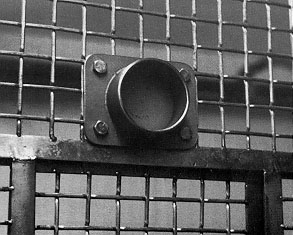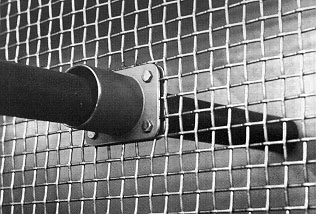By Viktor Reinhardt and Richard Pape
Perches offer inexpensive environmental enrichment for caged non-human primates [1-5]. By providing an elevated sitting position, a perch opens a new dimension for the animal. It also offers a dry, comfortable refuge while the caretaker sprays the cage floor during daily cleaning.
Installing a perch is a bigger problem with squeeze-back than with standard cages, because the perch can interfere with the restraint mechanism. Two solutions to the problem have appeared in the literature, though both have drawbacks. The first solution has the perch mounted in the back wall of the cage, so the bar-spacing of the squeeze-back limits the diameter of the perch [4]. The other solution requires animal care staff to remove the perch whenever they operate the squeeze-back [1]. We developed an alternative that avoided both drawbacks.
We used two tricks: a stainless steel socket mounted inside the front of the cage (Fig. 1) and a stainless steel sleeve penetrating the squeeze-back (Fig. 2). To install the sleeve, we cut a hole in the squeeze-back, exactly in line with the socket. (The length of the perch always equals the depth of the cage.) The sleeve protruded about 60 mm into the cage; the diameter of sleeve and socket was about 10 mm larger than that of the perch. With both the door and the front of the cage open, we inserted the perch in the sleeve; then we closed the front of the cage and fit the proximate end of the perch into the socket.


The sleeve glides over the perch, so the squeeze-back moves freely; there is no need to remove the perch. Two natural parameters - not the bar-spacing of the squeeze-back - determine the diameter of the perch: the animal's weight (the perch should not bend under the animal's weight) and the diameter for a comfortable sit (the animal should be able to balance on the perch without having to hold the cage ceiling or walls).
Facilities that have cages with a fixed front wall must have a hole cut in that wall. Animal care staff would introduce the perch through this hole, insert its far end in the sleeve, fit the proximate end into the socket, then mount the socket over the hole
References
1. Contel, N.R. Letter to the editor. Lab. Anim. Sci.; 39: 537, 1989.
2. Reinhardt, V. and Smith, M.D. PVC pipes effectively enrich the environment of caged rhesus monkeys. Laboratory Primate Newsletter; 27(3): 4-5, 1988.
3. Reinhardt, V. Evaluation of the long-term effectiveness of two environmental enrichment objects for singly caged rhesus macaques. Lab Animal; 18(6): 31-33, 1989.
4. Schmidt, E.M., Dold, G.M., and McIntosh, J.S. A perch for primate squeeze cages. Lab. Anim.
Sci.; 39: 166-167, 1989.
5. Wolff, A.V. Polyvinyl chloride piping as perch material for squirrel monkeys. Laboratory Primate Newsletter; 28(l): 7, 1989.
Viktor Reinhardt is assistant attending veterinarian and Richard Pape is shop supervisor at the Wisconsin Regional Primate Research Center. Send reprint requests to Viktor Reinhardt, Wisconsin Regional Primate Research Center, 1223 Capitol Court, Madison, WI 53715. The environmental enrichment program is supported by NIH grant RR-00167 to the WRPPC.
Reprinted with permission of the publisher.
This article originally appeared in Lab Animal, volume 20, number 8.